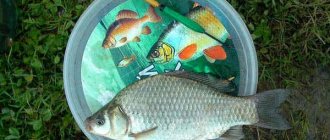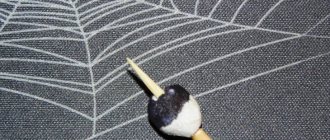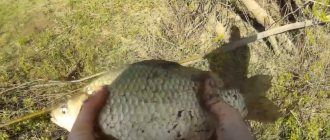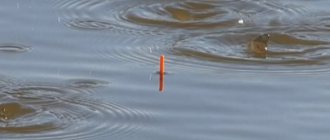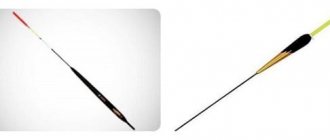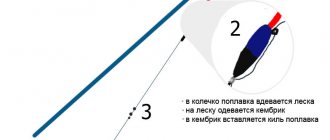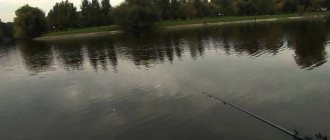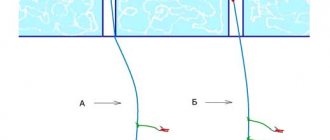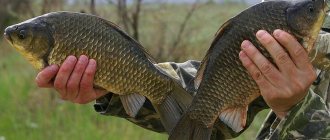"Float for crucian carp." Many novice anglers collecting float gear for catching crucian carp are wondering how to choose alarms?
After all, you have to hunt for crucian carp in a variety of conditions, with different gear, and it is obvious that the floats for fishing with a fly rod will differ from those used for fishing at long distances.
In this article I will tell you how to choose the “right” floats for catching crucian carp.
Float for crucian carp - solid or sliding?
All alarms used for float fishing are divided into solid and sliding.
"Float for crucian carp"
The deaf ones are attached rigidly to the fishing line and move along it with effort.
Such floats are used in cases where the depth at the fishing spot does not exceed 3/4 of the length of the rod.
Most often, they are equipped with fly fishing rods.
But they are also used when fishing with Bolognese and match gear, when you have to fish in some shallow pond or river bay.
Sliding floats are used exclusively for fishing with rods with rings and a reel.
Such alarms slide freely along a fishing line or cord.
The fishing depth is set by moving the stopper-limiter.
With a sliding float you can make long and accurate casts.
Features of choosing a float
There is a large selection of sliding floats that have a single attachment point . These floats are suitable for small currents or standing water. The choice of model depends on the behavior and weight of the fish, as well as the fishing depth. The float element with a single attachment point provides a more accurate hookup and makes it easier to spot a bite on the rise. They are more accurate and smooth when casting.
If the current is strong, fishing with a sliding float will be difficult. He will dive, colliding with any debris that the current brings and create a false biting effect.
For fast currents, a fixed float . It is less susceptible to various obstacles and changes in current speed. This float element has two attachment points and does not require recessing the fishing line.
The rod for such fishing has a length reaching 4-8 meters and is equipped with guide rings. The floats are lowered to the level of the yellow stripe. The guide rings must be placed behind the body to ensure smooth movement of the float and prevent the fishing line from clinging to it.
When fishing at different distances, you need to take floats that have a replaceable antenna. You should wind up a smaller antenna as you decrease the fishing distance so that it is not so noticeable to the fish.
Float for crucian carp - selection criteria
What are the criteria for choosing floats?
You need to go fishing for crucian carp with delicate, inconspicuous equipment, so when buying alarms you need to pay attention to:
- Form.
- Weight.
- Load capacity.
- Number of fastenings.
- The thickness and length of the tip.
- Color.
Let's take a closer look at each point and figure out how to choose good floats. After all, they were going for crucian carp!
Stoppers
The easiest way is to buy silicone stoppers, especially since their types today are varied in color and size. For live bait fishing rods, the use of such a stopper is ideal in terms of both simplicity and quality.
But for long-distance fishing, it is very important for the stopper to pass through the rings of the rod, and here not every silicone bead can easily slip through them.
Therefore, when purchasing, be sure to pay attention to this or make a stopper yourself using a special sliding knot.
The locking knot for the sliding float is not difficult to knit. After several training sessions, you will be able to knit it with your own hands with your eyes closed. Here are step-by-step instructions on how to do it correctly:
- We take a piece of fishing line about fifteen centimeters long and fold it in half.
- We place the folded loop near the main fishing line of the tackle.
- Holding this loop near the working line with the fingers of one hand, we begin to wrap one of the ends of the loop around its second segment and the working cord.
- Having made 6-8 turns, we return the end of the fishing line to the original loop and, after wetting the knot, slightly tighten it, leaving the ends a couple of centimeters.
We will carry out the final tightening of the knot and cutting off the ends of the fishing line already on the reservoir, when we have precisely determined the fishing point, taking into account the casting distance, the speed of the current and the depth of the place.
Float for crucian carp - body shape
According to the body shape, floats are:
- round,
- fusiform,
- conical,
- teardrop-shaped,
- elongated.
Body shape directly affects flight performance.
For example, elongated floats such as wagglers, designed for fly fishing, have very low drag during flight, so they can be cast over very long distances.
But the pot-bellied teardrop-shaped models float a lot during flight, so they are best used when fishing at short distances.
Please also take into account the fact that volumetric floats provide greater resistance when biting. This can scare away such cautious fish as crucian carp. Therefore, whenever possible, choose streamlined floats with a small body.
How to properly load a float
Loading plays a big role in setting up the float. The fish should not feel even the slightest resistance when the gear is immersed. This can be achieved if only the tip sticks out of the water.
To check whether the load is sufficient, you need to take a cut plastic bottle of 2-3 liters. First, the float is surrounded by one large sinker and a second smaller one, equal in weight to the float. During a test dive in a bottle, only the tip should stick out of the water on the surface. Depending on the result, the weight is reduced or increased by removing or adding weights.
In order for the catch to be rich, you need not only to choose the right gear, but also not to forget that crucian carp is weather sensitive and reacts to changes in atmospheric pressure.
If there is a sharp jump, it is better to cancel fishing - there will be no bite. Article on the topic: Hooks for crucian carp
Float for crucian carp - weight
This refers to your own weight. The larger it is, the further the angler can cast the equipment.
Therefore, if you are going to fish with a match rod or lapdog, I recommend getting both light and heavy floats.
When you get to the fishing spot and determine the distance to the fishing point, you can choose the alarm that you need.
Always try to use the lightest possible floats for catching crucian carp.
They are more sensitive and create less noise during splashdown.
Load capacity
Load capacity indicates the weight of the load that is necessary to sink the float to the desired level.
Models for fishing with a fly rod rarely have a carrying capacity of more than 5 grams.
If large numbers are indicated on the body, then these are match and Bolognese floats.
For crucian carp, it is advisable to take a float with a minimum carrying capacity.
There is no need for excess lead on the equipment - it will make it rougher, and the chances of a bite will decrease in inverse proportion to the increase in the weight of the load.
Number of fasteners
Both sliding and “blind” floats can have one or several attachment points. Both have their advantages and disadvantages.
But if we talk about which floats are better suited for catching crucian carp, then it’s definitely worth choosing models with one attachment point.
Firstly, they are more sensitive and create less resistance during biting and hooking.
And secondly, such floats do not catch algae and duckweed, unlike models with two attachment points. Because crucian carp most often have to be caught in heavily overgrown reservoirs; this feature is extremely useful.
Antenna
The antenna is the visible part sticking out of the water.
The main requirement for the top is that it must be clearly visible.
Think about this when choosing alarms for your float rod.
So, if you catch crucian carp with a fly rod 5-6 meters from the shore, choose models with thin, short antennas.
But if the fishing distance is long, the antenna should be long enough and thick. Then you will be able to detect a bite from a long distance.
Features of a fishing rod for long casting
For fishing with long casting, fishing rods with a long rod , which can reach 3.6-4.5 m. The fishing rod must be sufficiently rigid, but at the same time have little weight. A fast action is used for this type of rig. The knees of the rod bend closer to the top and maintain rigidity in the rest of the rod. This type of structure helps to maximize the distance of casting the bait.
The rod for long casting has the form of a plug design with three elbows. For compactness during transportation, it is better to choose models with 4-6 parts. The handle is made of cork or rubber with a porous texture.
Match reels are ideal for long casting due to their long, lightweight spool and small convex drum. This design allows you to use thinner lines.
The softness and reliability of the product depends on the number of bearings on the reel. But with a large number of them, the weight of the fishing rod also increases, which can lead to rapid hand fatigue. Therefore, it is necessary to choose a product for yourself that will be optimal in terms of smoothness and overall weight.
Amateur fishing allows the use of fishing line with a diameter of 0.12-0.18 mm. For sport fishing, the thickness is reduced to 0.1-0.16 mm. A fishing line 60-80 m long is wound onto a reel with a release of 0.5-2 mm from the edge. If you choose a fishing line with a higher density than water, it will sink well without reacting to the wind.
Body color
Body color, or rather its effect on bite, is constantly discussed on forums.
Conventionally, fishermen are divided into two camps: some stubbornly argue that the color of the float has absolutely no meaning, while others insist that bright colors can scare away fish.
Which of them is right, and to which camp does the author of this article belong? I agree, with some and with others.
Sometimes the color of the float does not affect the fishing performance at all. If you catch crucian carp at a depth of 3-4 meters, and it takes from the bottom, then I give you a 100% guarantee: the fish does not see your float, and its color does not matter.
But if the depth at the fishing spot is less than a meter, then it’s worth worrying about the color. Choose floats in natural colors. Then the fish will identify the float with a natural, safe object.
In the end, various twigs and bark from trees constantly fall on the water, and the crucian carp is not afraid of them.
Float tackle for crucian carp with two hooks
No one knows the exact answer to the question: which bait will be more effective today? Therefore, fishermen quite often use float gear for crucian carp with two hooks. This helps save valuable time on selecting the most catchy bait; for example, you can put maggot on one hook, and decoy on the second.
There are a lot of options for making float tackle with two hooks. But I will only consider those that I tested on myself and which I liked the most. And if it seems to you that such a float tackle will be too complicated for catching crucian carp, then you are only imagining it. All the time spent tying knots and attaching hooks pays off with a good catch.
Let's move closer to the montages and look at each of them in more detail.
1. The rein with the hook is located immediately behind the sinker. The most common type of float tackle and probably the simplest. I don’t know exactly why, but most fishermen prefer to fish with it. This installation makes the tackle quite sensitive, but it is only suitable for catching active crucian carp; in order to lure sluggish fish you will need to experiment a little.
2. Float tackle for crucian carp with two hooks on identical leashes. It is best to attach the same bait to both hooks. Very often, fishermen put different baits on hooks, but this installation is not entirely suitable for this. It is more suitable for fishing with a large “balyabukha” of a makukha or something like that. The main disadvantage of such gear is that it gets confused very often.
3. Float tackle with two hooks on different leashes. For me personally, this is the best setup of gear and I use it almost every fishing trip. It is this installation that is best suited for choosing the most effective bait and saves your time.
4. Sinker between hooks tied to the main line. This installation allows you to catch crucian carp both at the very bottom and in the near-bottom zone. Excellent tackle for crucian carp, because it does not stay evenly at a certain depth and you often have to change it.
5. The tackle is the opposite, first the sinker with the hook, and then the float. A bit of a junkie tackle, but very interesting and functional. But fishing with it is not very convenient, it is most likely a marker, it allows you to immediately determine the exact depth at the fishing site, and then tie the hook using one of the methods described above.
I think many people have noticed that the complexity of the float tackle is quite high, and those who thought that this was a simple piece of equipment were very mistaken. You need to think through the equipment correctly and then mount it all correctly, but read about that below.
